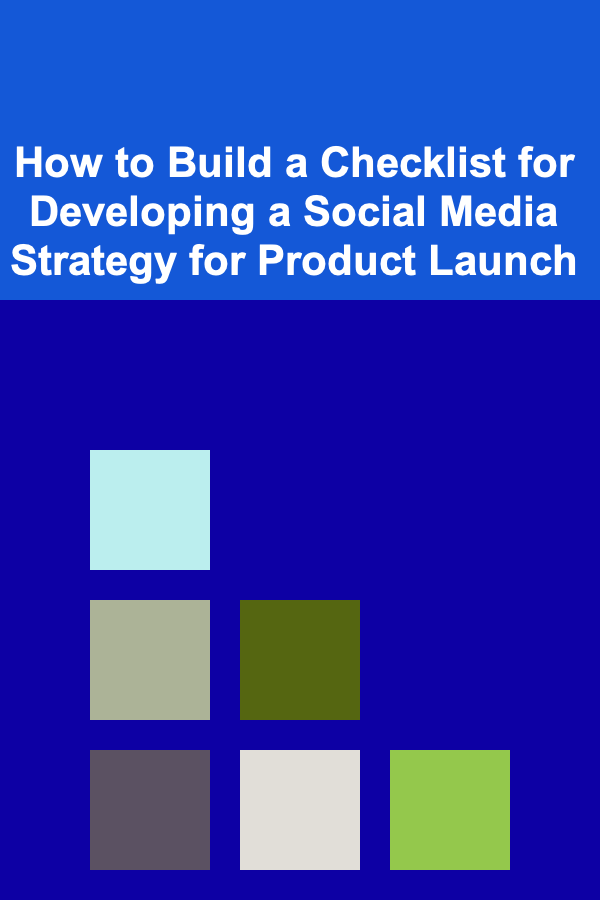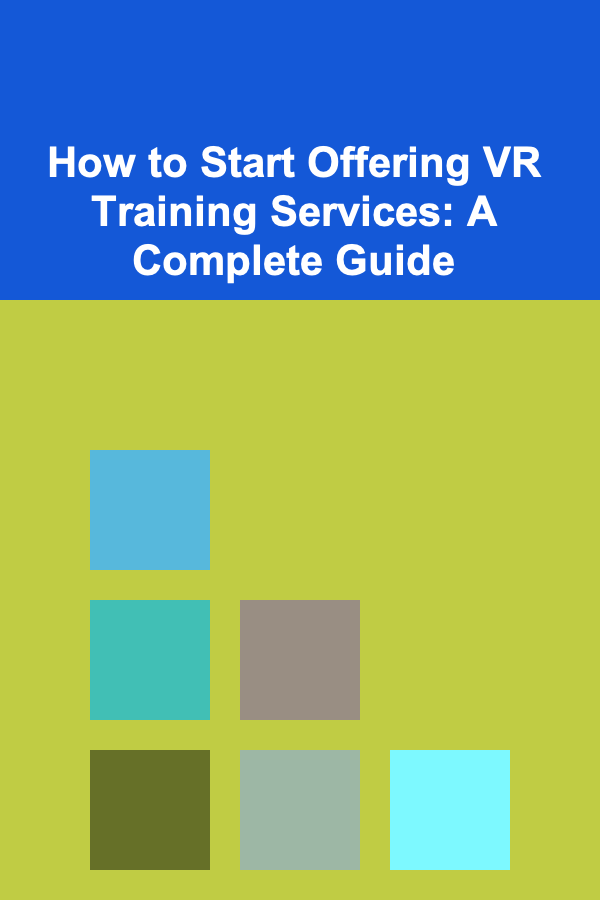
How to Build a Checklist for Developing a Social Media Strategy for Product Launch
ebook include PDF & Audio bundle (Micro Guide)
$12.99$7.99
Limited Time Offer! Order within the next:

When launching a new product, the right social media strategy can make or break the success of your launch. Social media is a powerful tool to build excitement, engage potential customers, and drive sales, but to achieve these results, you need a well-thought-out plan. Developing a social media strategy for a product launch involves multiple steps, from setting clear goals to measuring the impact of your campaigns.
In this actionable guide, we'll break down how to build a comprehensive checklist for developing a social media strategy that can help you create buzz and ensure the success of your product launch.
Set Clear, Measurable Goals
Before diving into your social media strategy, you need to define your goals. Without clear objectives, it will be difficult to measure the effectiveness of your strategy.
Key Questions:
- What do you want to achieve with the product launch on social media?
- Drive product awareness?
- Increase pre-orders or sales?
- Grow your follower base?
- Engage your community or get user-generated content?
Tips:
- Be SMART: Ensure your goals are Specific, Measurable, Achievable, Relevant, and Time-bound.
- Focus on Key Performance Indicators (KPIs): These could include engagement rate, click-through rate (CTR), conversion rate, website traffic, etc.
Example:
- Increase website traffic by 25% within the first 30 days after the product launch.
- Get 50% more engagement (likes, shares, comments) compared to previous posts.
Define Your Target Audience
Understanding who you're speaking to is essential for creating relevant and engaging content. A well-defined target audience allows you to tailor your social media messaging and ad campaigns to the right people.
Key Questions:
- Who are your potential customers?
- What are their pain points and desires?
- Which social media platforms do they use most?
Tips:
- Create buyer personas: These are detailed profiles of your ideal customers, including demographics, behaviors, interests, and challenges they face.
- Analyze current audience insights: Use analytics from your existing social media profiles to see who is already engaging with your brand.
Example:
If you are launching a fitness product, your target audience might include health-conscious millennials who engage with fitness influencers on Instagram and YouTube.
Select the Right Social Media Platforms
Not all social media platforms are suitable for every product or audience. Understanding where your target audience spends their time will help you choose the best platforms for your product launch.
Key Questions:
- Which platforms does your target audience use most?
- Do you need a strong visual presence (Instagram, Pinterest), or will long-form content (YouTube, LinkedIn) work better?
Tips:
- Focus on 2-3 platforms initially: Don't stretch yourself too thin. Choose platforms that align with your audience's behavior and your content strategy.
- Consider platform-specific content formats: Each platform has its own strengths---Instagram is visual and great for influencer marketing, LinkedIn is ideal for B2B products, etc.
Example:
- Instagram and TikTok are great for a fashion or lifestyle product targeting young consumers.
- LinkedIn is better for B2B products like software or consulting services.
Develop Compelling Content
Content is the backbone of your social media strategy. The content you create should build anticipation, educate your audience, and drive conversions.
Key Questions:
- What type of content will resonate with your audience?
- Will they respond to product teasers, behind-the-scenes content, or educational posts?
- Do you need to create videos, images, or long-form blog posts?
- How will you tell the story of your product?
Tips:
- Create a content calendar: Plan content well in advance, starting from teaser posts months before launch to post-launch celebrations. This ensures you maintain a consistent presence.
- Use different content formats: Blend video, images, stories, and even live streams to keep things dynamic.
- Highlight product benefits: Showcase how your product solves a problem for your audience.
Example:
- Pre-launch: Tease the product with sneak peeks, countdowns, and behind-the-scenes content.
- Launch day: Announce the product with high-quality images and videos that highlight its features and benefits.
- Post-launch: Share customer testimonials, unboxing videos, and user-generated content.
Leverage Influencers and Partnerships
Influencer marketing can amplify your product launch efforts by reaching a wider, highly engaged audience. Partnering with influencers who align with your brand values can help build credibility and excitement for your product.
Key Questions:
- Which influencers or brands align with your values and audience?
- What type of content will influencers create (e.g., unboxing videos, reviews, tutorials)?
Tips:
- Choose influencers with high engagement, not just large follower counts: The most important metric is how engaged their followers are.
- Provide influencers with clear guidelines: Ensure they understand your product's benefits, the launch timeline, and the message you want to convey.
- Offer exclusivity: Early access or exclusive offers to influencers can encourage them to promote your product more authentically.
Example:
- Partner with a tech influencer to showcase the unique features of your new gadget or app.
- Collaborate with a lifestyle blogger to review your new wellness product on their Instagram story.
Plan Paid Social Media Ads
While organic reach is valuable, paid advertising on social media can give your product launch a significant boost. Platforms like Facebook, Instagram, and LinkedIn offer targeted advertising options that allow you to reach your exact audience.
Key Questions:
- What budget do you have for paid ads?
- Which social platforms should you run ads on?
- What ad types (carousel, video, story, sponsored posts) will best showcase your product?
Tips:
- Run retargeting ads: These ads target users who have previously visited your website or interacted with your social media profiles.
- Create urgency with limited-time offers: Use time-limited discount codes or countdowns in your ads to create a sense of urgency.
- Test different ad creatives: A/B test different visuals, copy, and calls to action to see what works best.
Example:
- Run Instagram ads featuring product demos or reviews from influencers to build trust and drive purchases.
- Use Facebook's carousel ads to showcase different features or angles of your product.
Engage with Your Audience
Social media is a two-way street, and engagement is key to building lasting relationships with your customers. Responding to comments, answering questions, and thanking people for their support can help strengthen your brand's reputation and foster loyalty.
Key Questions:
- How will you engage with your audience during the launch?
- What platforms will you use for customer support?
Tips:
- Use social listening tools: Track mentions of your product and brand to quickly respond to any questions or concerns.
- Encourage user-generated content: Run contests or campaigns encouraging followers to share their experiences with your product using a branded hashtag.
Example:
- Respond promptly to any inquiries on your product's post-launch posts.
- Share user-generated content like unboxing videos, reviews, or photos of customers using your product.
Monitor, Analyze, and Adjust
After launching your product on social media, it's crucial to track the performance of your campaigns to determine what worked and what didn't. Monitoring real-time metrics and adjusting your strategy ensures you stay on track to meet your goals.
Key Questions:
- Which KPIs are most important to track for your goals?
- What tools will you use to measure your results (e.g., Google Analytics, social media insights, Hootsuite)?
Tips:
- Track engagement and conversions: Keep an eye on likes, shares, comments, and clicks to see how well your content is resonating.
- Adjust your strategy based on performance: If a certain post type or ad format performs better, optimize your future posts based on those insights.
Example:
- If video content is receiving higher engagement, plan more video content for the next phase of the launch.
- Use feedback from customers or followers to adjust the messaging or visuals of your next post.
Post-Launch Engagement
Once the initial product launch buzz settles, continue engaging your audience by providing value and keeping the conversation going.
Key Questions:
- How will you keep the momentum going after the product launch?
- What kind of content can you create for long-term engagement?
Tips:
- Share product updates: Highlight new features, updates, or improvements made based on customer feedback.
- Focus on building community: Use social media to create ongoing conversations, share relevant content, and build customer loyalty.
Example:
- Post customer success stories, testimonials, or case studies to show how people are benefiting from your product.
- Continue to engage with followers by answering questions and creating content around common challenges your product helps to solve.
Conclusion
Building a comprehensive social media strategy for a product launch requires meticulous planning, creativity, and consistent effort. By following the steps outlined in this checklist, you'll be well on your way to creating a successful launch campaign that generates excitement, engages your audience, and drives meaningful results. Remember, every launch is an opportunity to connect with your customers and build your brand's presence, so make sure to approach it with careful consideration and a focus on long-term growth.

DIY Birthday Party Themes and Decorations: Fun Ideas for a Memorable Celebration
Read More
How to Decorate with Budget-Friendly Home Accessories
Read More
How to Start Offering VR Training Services: A Complete Guide
Read More
How to Develop Early Philosophical Thinking
Read More
How To Install a Smart Lock: A Comprehensive Guide
Read More
How to Find a Fee-Only Personal Finance Planner
Read MoreOther Products

DIY Birthday Party Themes and Decorations: Fun Ideas for a Memorable Celebration
Read More
How to Decorate with Budget-Friendly Home Accessories
Read More
How to Start Offering VR Training Services: A Complete Guide
Read More
How to Develop Early Philosophical Thinking
Read More
How To Install a Smart Lock: A Comprehensive Guide
Read More